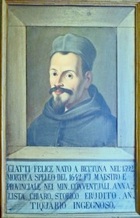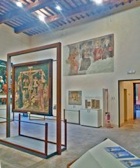

Although Bettona was a small Commune overshadowed by powerful neighbours (Perugia, Assisi and Foligno), it was fiercely independent. Thus, when it submitted to Assisi in 1222, it did so through its Consul (who seems to have been its leading official) and its Consiglio Generale (General Council). The transfer of the relics of St Crispoltus in 1265 from the Abbazia di San Crispolto (over which the bishops of Assisi had rights) to a new church within the walls probably represented an assertion of municipal independence.
The office of Podestà probably provided the route by which Bettona’s powerful neighbours extended their influence over its affairs. This back-fired spectacularly in 1352, when the Perugian Podestà of Bettona, Crispolito de' Crispolti, betrayed the town to the soldiers of Giovanni Visconti of Milan, an event that prompted the vengeful Perugians to execute Crispolti and sack Bettona.
From 1516, the Baglioni counts lived in nearby Palazzo Baglioni. However, they maintained a lieutenant general in Bettona, as well as civil and criminal judges. It is likely that the buildings described below accommodated these officials until 1648 (when the last of the Baglioni died), and that they were used by officials of the papal administration thereafter.
Palazzo Comunale (16th century)
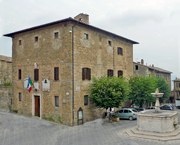
The Podestà was soon to have a new palace (see below). Nevertheless, this palace also remained in use, and it was rebuilt in the 16th century. It is still in use, and can be visited during the hours that the Municpal offices inside are open.
The choir stalls (ca. 1502) in the present Sala Consigliare are from Convento di Sant’ Antonio da Padova.
Palazzo del Podestà (1379)

Roman Inscription (late 1st century BC)
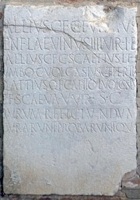
-
✴the quattuorviri iure dicundo:
-
•[Titus] Allius, son of Caius; and
-
•Cnaeus Fuficius Laevinus, son of Cnaeus; and
-
✴the quinqueviri:
-
•[Caius] Allius, son of Caius;
-
•Caius Scaefius Umbo, son of Lucius;
-
•Caius Volcasius Pertica, son of Caius;
-
•Quintus Attius Capito, son of Quintus; and
-
•Lucius Volcasius Scaeva, son of Caius.
Another inscription (CIL XI 5392), which is identical except that the names of the quattuorviri are reversed, was found in the central piazza of Assisi and is now in the Museo Civico, Assisi (exhibit 25). Although it is possible that one or both of these refer to a restoration of the walls of Bettona, it is much more likely (given the form of the magistracy) that both came from Assisi.
Roman Inscription (late 1st century BC)
This funerary inscription (CIL XI 5195), which was found in an unknown location at Bettona, is now embedded in the external wall of the palace. It commemorates:
L(ucius) Marius C(ai) f(ilius)/ [Le]monia.
This tribe suggests that Marius came from Hispellum, a veteran colony that was formed by the triumvir Octavian (later the Emperor Augustus) in ca. 40 BC, and it is possible that Marius had been a veteran settled on land that had been confiscated at about the time of the Perusine War.
SS Peter and Paul and Coats of Arms (14th and 15th centuries)
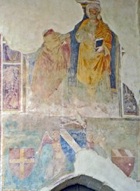
-
✴The standing figures of SS Peter and Paul (14th century) are probably the work of an artist from Orvieto. The figure of St Paul (on the left) is badly damaged.
-
✴Below, the fresco below, two angels holds the arms of Pope Eugenius IV (1431-47). The arms of Bettona are to the left and there is another coat of arms to the right.
Interior
Maestà with saints (1380)
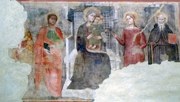
Art from the Palace
Portraits (19th century)
Two half-length portraits in the Pinacoteca Civica, which depict Malatesta IV Baglioni and Felice Ciatti, probably belonged to a series of images of famous citizens commissioned for the Palazzo del Podestà.
-
✴Malatesta IV Baglioni, Count of Bettona was a famous mercenary soldier until he betrayed the city of Florence in 1530 (when the Emperor Charles V re-installed the Medici there). He retired to Bettona and died in Palazzo Baglioni in 1531.
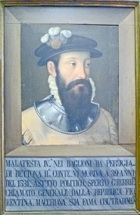
-
✴Felice Ciatti, who was born in Bettona in 1592, became Provincial Minister of the Franciscans. He was an eminent historian and one of the first to study the Etruscans, He died at Spello in 1642.
